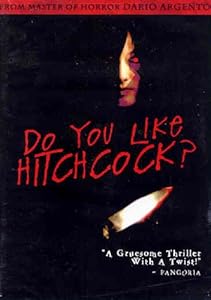It took me five years to build up the courage, but I finally took the dive into Dario Argento’s stab (pun sadly intended) at an homage to Alfred Hitchcock, his 2005 thriller Do You Like Hitchcock? (DYLH).
The answer to the film’s questioning title is, of course, an unhesitant Yes. Alfred Hitchcock’s films stand to this day as a testament to his talents, and remain some of the top examples of the perfection of the filmmaking craft. He didn’t earn the moniker “The Master of Suspense” for nothing, don’t you know? What you should ask yourself before treading into this film isn't whether or not you are a fan of Hitchcock’s work. The question you should be answering is “Do you like Argento?”
DYLH starts in 1990 when a young boy bicycling through the woods happens upon and spies on two heavyset women dressed like French peasants as they cackle hysterically while sacrificing a live chicken. The
boy is then spotted and chased away by the women before the film switches to modern day. This inexplicable opening is unforgettable not only because it is never fully explained, but because it is the last remotely interesting thing that takes place in the film. By the time the now grownup geeky film student Giulio kinda-sorta solves the murder of the woman across the street, you will be fondly recalling the chicken-killing scene with a deep and unsettling longing for that kind of creative storytelling.
The post-chicken remainder of the film revolves around annoying peeping-tom Giulio and his attempts to solve his neighbor’s murder. Most of this involves painfully extended scenes of Giulio spying on women, sporadically interrupted by inane snippets of dialogue and the occasional discovery of extremely lame clues, with the emphasis firmly on “lame.” Argento’s screenplays usually eschew logic and common sense, and DYLH finds him at the top of his illogical game, with the reason behind the real killer’s eventual unmasking acting as the cherry on top of this WTF sundae. Honorable mention goes to the unintentionally comical chase scene in which an eighty-seven pound bookworm with a broken leg and stalled scooter is relentlessly pursued through a torrential downpour by a bald linebacker who needs to stop and catch his breath every ten or twelve steps.
Like most of the films from the second half of his career, the world within DYLH is populated solely by the Beautiful and the Ugly. There are no average people walking the almost barren streets of Argento’s Italy, only potential underwear models and comically hideous freaks. That the film’s chicken-chested voyeuristic hero falls into the latter category is possibly the only real mystery of the film. This bizarre ‘Beauties vs. Beasts’ world view is quickly becoming as much a trademark as his fondness for extreme close-ups and showing the unknown killer’s hands and feet whenever possible.
I’m tempted to declare the tragic display of Argento’s supposed homage to Hitchcock as the real victim of the film. Argento goes out of his way to squeeze as many Hitchcock classics into the plot as possible; Strangers on a Train and Dial M for Murder are both mentioned by name, while Rear Window, Psycho and Vertigo make painful cameos. He then proceeds to toss around these hastily assembled masterpieces with all the grace and subtlety of a crack head trying to nonchalantly hide his stash while a State Trooper patiently taps on the windshield. For what was supposedly meant to be an homage, Argento only succeeds in doing to Hitchcock's memory what he previously had done to his daughter, Asia Argento, in The Stendhal Syndrome. And that's being nice about it.
But alas, the true tragedy occurs at the end, when Argento tries to inject a deeper meaning by showing Giulio and his binoculars being discovered and casually dismissed by his new semi-nude neighbor, and quickly intercutting a series of flashbacks to all of his previous peeping activities within the film. It’s a sloppy last-minute attempt to make the film a message about voyeurism, when the whole sordid affair amounts to nothing more than a filmmaker tragic stab at mimicking greatness.
A final warning; the film’s official summary promises a surprising twist at the end of the film. It’s a lie, unless the complete lack on anything even remotely resembling a twist was the intended twist. But I have a feeling that would be giving Argento far more credit than he deserves. DYLH is as boring, predictable, and ludicrous as they come.
Do I like Argento? Nah.
Don't believe that it is as bad as I make it out to be? Don't take my word for it. Watch the entire film for free below.

![Reblog this post [with Zemanta]](http://img.zemanta.com/reblog_e.png?x-id=bb3ddaa4-6ddb-496b-ab23-dfde38cae26f)

![Reblog this post [with Zemanta]](http://img.zemanta.com/reblog_e.png?x-id=91a0cbba-f6a0-4118-9304-b6a5251398cd)